CNC fixtures are integral components in the world of precision machining. These custom-designed tools hold and stabilize workpieces during the CNC (Computer Numerical Control) machining process, ensuring accuracy, repeatability, and efficiency. Whether you’re machining simple or complex parts, a proper fixture ensures that each workpiece stays securely in place, allowing the CNC machine to operate with minimal deviation. In this article, we’ll explore what CNC Fixture are, their role in machining, the types of fixtures, design considerations, and how they contribute to efficient, high-quality production.
What Is a CNC Fixture?
A CNC fixture is a device that holds and positions a workpiece during the machining process. It ensures that the part is correctly aligned and stabilized throughout various machining operations, such as milling, drilling, turning, or grinding. By securely holding the part, CNC fixtures prevent unwanted movement that could cause errors in the final product.
While standard workholding tools like vises and clamps are often used in machining, CNC fixtures go a step further by providing more precise and repeatable holding mechanisms. Custom-designed for specific applications, these fixtures reduce setup times and allow for high-volume, consistent production. They are designed to accommodate various machine types, including CNC mills, lathes, and multi-axis machines.
Why Are CNC Fixtures Important in Manufacturing?
The primary function of a CNC fixture is to ensure the stability and accuracy of a workpiece during machining. Here are some reasons why CNC fixtures are essential:
1. Precision and Accuracy
CNC fixtures are critical for ensuring that the part is positioned correctly relative to the cutting tools. Any misalignment can lead to inaccurate cuts, poor-quality finishes, or dimensional errors, which can be costly. By holding the workpiece firmly in place, fixtures ensure that the machine cuts exactly where it is intended, leading to consistent, high-quality results.
2. Repeatability
Fixtures provide repeatability by allowing the same part setup to be replicated precisely. Once a fixture is designed and set up, it can be reused multiple times with minimal adjustments. This is particularly valuable for high-volume production runs, where parts need to be machined in the same manner to maintain consistency and quality.
3. Safety
A CNC fixture secures the part in place, reducing the risk of the workpiece shifting or vibrating during machining. This minimizes the chances of injury to operators or damage to the machine tool. Fixtures also prevent the part from becoming a projectile, which could be hazardous.
4. Increased Efficiency
By holding the workpiece in place securely and precisely, CNC Fixture allow for faster machining operations and fewer interruptions. This is especially important in industries where time is money, such as aerospace and automotive manufacturing. With fixtures in place, the need for constant adjustments and repositioning of the part is minimized, resulting in higher throughput.
5. Reduced Setup Time
CNC fixtures are designed to simplify the setup process. For example, some fixtures feature quick-change mechanisms that allow workpieces to be loaded and unloaded quickly, reducing machine downtime and improving overall production efficiency. Fixtures can also be pre-set for specific parts, eliminating the need for complex recalibration for every cycle.
Types of CNC Fixtures
CNC fixtures come in many different types, each designed to suit the specific requirements of the machining operation. Some of the most common types of CNC fixtures include:
1. Milling Fixtures
Milling fixtures are used in CNC mills, which use rotating cutting tools to remove material from a workpiece. These fixtures are designed to hold parts securely during the milling process, preventing any movement that could affect the final part’s accuracy. Milling fixtures can be designed for both simple and complex parts, and they often include components like clamping devices, locators, and support blocks.
Milling fixtures may be fixed, meaning they are permanently attached to the machine bed, or adjustable, allowing for modifications to accommodate different workpieces. The fixture may also have multiple sides or faces to allow for multi-sided machining without needing to reposition the workpiece.
2. Turning Fixtures
Turning fixtures are used in CNC lathes, where the workpiece rotates against a stationary cutting tool. These fixtures are primarily used to hold cylindrical or round parts in place during the turning process. The fixture may include a chuck, collet, or jaw system to grip the workpiece firmly.
Turning fixtures are typically simpler than milling fixtures because turning operations are generally focused on parts with rotational symmetry. However, they still need to provide secure holding for parts during high-speed rotations to prevent deflection or shifting.
3. Drilling Fixtures
Drilling fixtures are used to secure parts during drilling operations, where a rotating drill bit creates holes in the workpiece. These fixtures are often designed to hold parts in a specific orientation relative to the drill bit, ensuring accurate hole placement. Drilling fixtures can include features such as locator pins, clamping mechanisms, and adjustable components to accommodate various part sizes and hole patterns.
Drilling fixtures are used to avoid misalignment between the workpiece and the drilling tool, ensuring that holes are drilled at precise locations and depths.
4. Assembly Fixtures
While CNC machining is often associated with cutting, turning, and drilling, assembly fixtures are used in operations where parts are put together, tested, or checked. These fixtures are designed to hold components in a specific alignment while they are being assembled. Assembly fixtures are commonly used in industries like automotive and aerospace, where complex assemblies of parts are common.
5. Inspection Fixtures
Inspection fixtures are designed to hold parts during the quality control and inspection process. These fixtures are essential in verifying that the machined parts meet the required specifications, dimensions, and tolerances. Inspection fixtures often feature integrated measuring instruments such as dial indicators or coordinate measuring machines (CMMs) to facilitate precise measurement during inspection.
Key Considerations When Designing CNC Fixtures
Designing a CNC fixture requires careful consideration of various factors to ensure it functions as intended. Key design considerations include:
1. Part Geometry and Size
The geometry and size of the workpiece are primary considerations when designing a fixture. Complex parts with irregular shapes may require custom fixtures that incorporate features like adjustable clamping mechanisms or multiple locating points. For simpler, standardized parts, a more basic fixture design may suffice.
2. Clamping and Holding Mechanisms
Effective clamping is one of the most critical aspects of fixture design. The fixture must securely hold the part without causing deformation or shifting during machining. Clamping mechanisms can be mechanical (e.g., manual clamps), pneumatic (using air pressure), or hydraulic (using pressurized fluid). The choice of clamping mechanism depends on factors such as the size and shape of the part and the forces involved in the machining operation.
3. Material Selection
The material used to construct a CNC fixture must be durable enough to withstand the forces and stresses of the machining process. Steel is a common material due to its strength and rigidity, but aluminum and other alloys may be chosen for lighter parts or where weight reduction is necessary. Materials should also be resistant to wear and corrosion to ensure long-lasting fixture performance.
4. Ease of Setup and Loading
A well-designed fixture should make the setup process as efficient as possible. Fixtures with quick-change capabilities or self-aligning mechanisms help reduce the time needed to load and position parts, which improves production efficiency. Pre-setting fixtures for specific parts is also beneficial for reducing downtime during high-volume production.
5. Repeatability and Consistency
The fixture should allow the workpiece to be placed in the same position every time, ensuring that parts are machined to the same specifications. This repeatability is critical in industries with high-volume production runs, as it helps eliminate errors and reduces the need for rework.
The Benefits of CNC Fixtures
CNC fixtures offer several benefits to manufacturers, including:
- Enhanced Precision: CNC fixtures hold workpieces with high precision, reducing the risk of misalignment and ensuring parts are machined accurately.
- Increased Production Speed: Efficient fixture design reduces setup and machining times, resulting in faster production and higher throughput.
- Improved Repeatability: Fixtures ensure consistent placement of parts, making it possible to reproduce the same part quality over many cycles.
- Reduced Waste: Proper fixture design reduces the likelihood of errors, defects, and rework, which helps minimize scrap rates and improve yield.
- Better Safety: Fixtures keep parts secure during machining, reducing the risk of accidents or injuries associated with shifting parts.
Conclusion
CNC fixtures are an indispensable part of modern machining, enabling precision, consistency, and efficiency in manufacturing operations. They hold parts securely in place, minimizing movement and misalignment that could result in defective parts. The right CNC Fixture design ensures repeatable, high-quality results in high-volume production, leading to better cost efficiency, higher throughput, and fewer errors.
When designing a CNC fixture, manufacturers must consider factors like workpiece size, geometry, clamping mechanisms, and material selection. A well-designed fixture ultimately enhances the machining process, allowing for faster production times, better accuracy, and lower production costs. As industries continue to demand faster turnaround times and higher precision, CNC fixtures will remain a critical tool in achieving these goals.




